Okay folks, the time has arrived. It’s time to spice up this blog!
Over the next few weeks and months, I’ll take you on a culinary journey around the world. Together with my wife, I’ll prepare, eat and describe some recipes from the countries Compassion works in. Hopefully, they’ll be enticing enough that you’ll want to try them out yourselves.
If you’d like to join us on this adventure, prepare the recipe and come back to tell us what you thought of the meal.
If you write about your meal on your blog, share a link to your post below so we have more than one perspective represented here.
So, to kick off our culinary series, I chose Moqueca de Peixe, a Brazilian fish stew recipe shared with us by Liv Almeida Nunes Ribeiro Dias, a Program Implementation Assistant with Compassion Brazil.
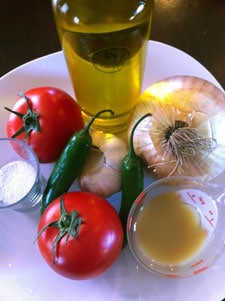 To tell you the truth, I chose this recipe because it didn’t seem too difficult to begin with. Despite watching hours and hours of the Food Network, I’m still cooking challenged, unless we’re talking tiramisu or my grandmother’s handmade ravioli.
To tell you the truth, I chose this recipe because it didn’t seem too difficult to begin with. Despite watching hours and hours of the Food Network, I’m still cooking challenged, unless we’re talking tiramisu or my grandmother’s handmade ravioli.
To begin with, Liv’s recipe calls for us to use sole, flounder or plaice. My fishmonger didn’t have any of those fresh, so I looked at the basa, a Vietnamese catfish. It was the only fresh white fish I saw.
However, my pregnant wife isn’t fond of bottom dwellers and we had a tense exchange about what to do because when I’m cooking it’s my way or the highway.
Fortunately, a second look at the fish counter, after my wife threw up her hands and walked away, revealed some tilapia which meant I didn’t have to sleep on the couch last night. Whew!
Although the recipe calls for one clove of garlic (chopped), when it comes to garlic in my house one means three.
The same Italian-style math applies to olive oil. More is better. Olive oil runs in my veins, which means I used three tablespoons instead of two.
To compensate for the extra garlic and olive oil I reduced the amount of salt. Actually, the recipe doesn’t specify how much salt to use.
When I cook I don’t use salt at all, but in this case, because the ingredients were fresh I used some (one teaspoon). However, the dish needed more salt than I used in order to bring out the flavors; I added more at the table.
The chili peppers were supposed to be chopped and seeded, but I like spicy so I left the seeds in and just chopped, chopped, chopped it all up. I didn’t notice any heat in the meal at all, and my wife who has a lower tolerance for spice didn’t think it was spicy either.
Next time, I’ll use four of five chilis.
After prepping the vegetables, I pureed them to make the marinade, which is essentially a salsa.
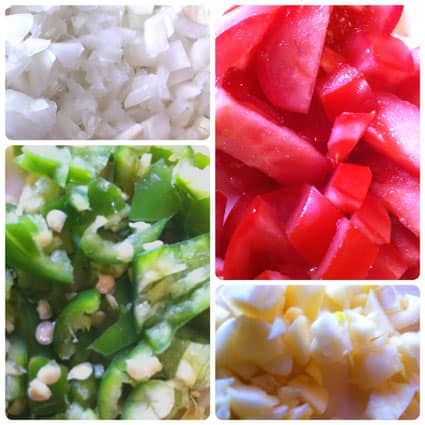
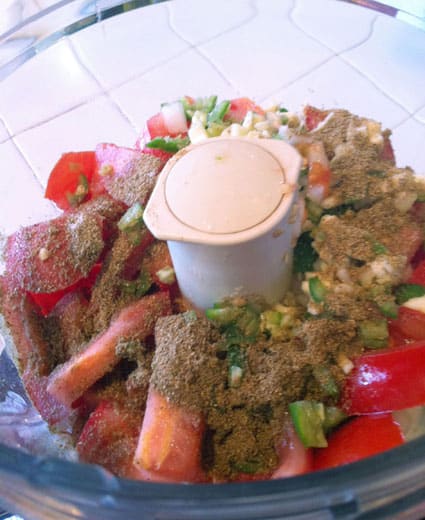
Then I introduced the salsa to the tilapia, “Hello,” and let it marinate in the refrigerator for an hour.
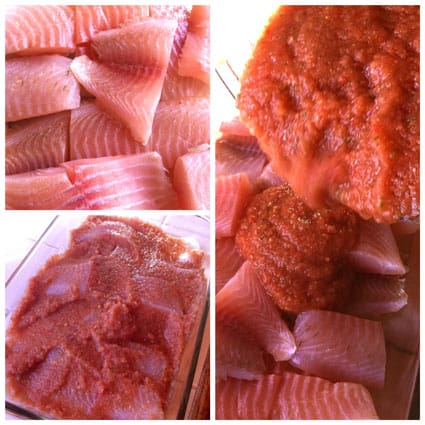
After an hour it was cooking time. The recipe says cook for five to 10 minutes.
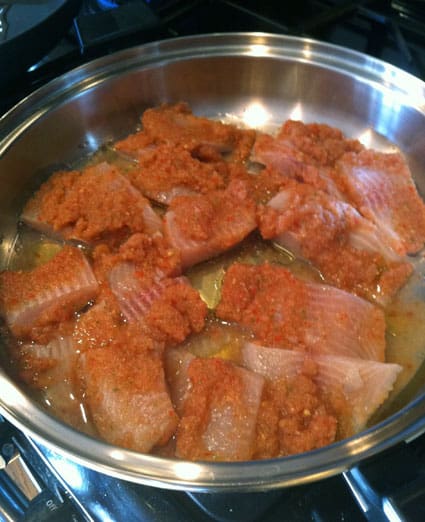
I split the difference and went with eight, which was perfect. Then served it up.
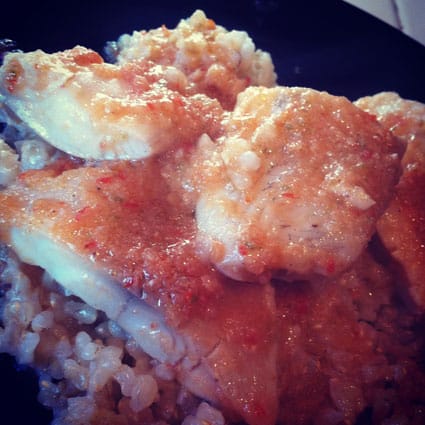
Although my wife and I both liked the meal and will certainly make it again, I think I’ll take a few more liberties with the recipe next time, to give it more plate appeal (color) and a more robust taste.
I suggest adding some red, green and yellow bell peppers (one each) to the mix, a can of coconut milk, a bottle of clam juice and black pepper to taste, maybe even crushed red pepper flakes.
Also, rather than using olive oil, it’s probably worthwhile to get some dende oil (a Brazilian palm oil).
I hope all of this doesn’t dissuade you from trying the dish, especially if you sponsor a child in Brazil. Give the recipe a try and let us know what you think of it by leaving a comment below.
Our next stop on the Amazing Compassion Culinary Adventure will be Mexico. We’ll be making Lasagna Azteca.
Allez Cuisine!

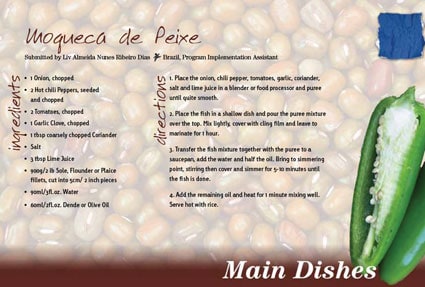






17 Comments |Add a comment
I made this dish for my family. We don’t sponsor a child in Brazil (Ecuador and Kenya), but we know missionaries that serve there.
My husband and I liked the dish – although the next time I make it I will take more liberties with it (we were expecting it to be spicier than it was). My children ate the “required number of bites” and called it quits. 😉
I finally was able to make this recipe (something about having your own kitchen makes it easier to cook in!). As a disclaimer, I dislike most fish, lime and anything hot (as in spicy), but I decided to try this recipe as I sponsor two boys in Brazil. I wasn’t able to find palm oil at my grocery store (they did have over a dozen other oil types, who knew that many existed). I used tilapia and used several bell peppers as Chris suggested (and minimal hot pepper). I thought it turned out decent considering how averse I am to some of the recipe ingredients. Before I tasted it, I was afraid I wouldn’t be able to eat any of it. I managed to eat it for dinner and actually will finish consuming it (I did make a half recipe) rather than give it away to someone or throw it out. I know that doesn’t sound like a resounding vote of approval, but considering my food preferences, the fact that I could eat it was a huge plus!
One question though-how is this recipe made by a typical poorer family in Brazil that does not have electricity and therefore a food processor or blender available? I don’t own either of those yet, and I simply chopped everything up-gave it good plate appeal with the green, red and yellow colors. Is that what a Brazilian family would do without a blender or food processor?
Becky,
The Brazil office confirmed that this dish isn’t something that would typically be prepared by the families of our sponsored children. It’s a dish that is representative of the culture overall.
I was told “moqueca is a more refined way to prepare the fish. It is very common in restaurants, but families also prepare it at their homes. In the houses of our sponsored children they prepare the fish in “rustic” ways – fried usually.”
Although this dish is representative of Brazil, I’m not sure if it’s something eaten by poor families. I’ll ask.
I’m assuming that coriander in this case is referring to the leaves (cilantro), not the seeds?
this is such a great idea, chris! i look forward to reading more of the recipes. by the way, i’m from thailand. 😉
Such a great idea!! I can’t wait to see other recipes!! And to give them a try….
Love the cook with compassion theme & can’t wait to see all the recipes you post! Hope there’s something I can write to my kiddo in India about! Now to go hunt up some fish…
I love your idea and I look forward to reading about the recipes you try in the future. Including the step by step photos of each stage of the cooking process is brilliant.
I think this is a great idea! The mother of one of my little sponsored girls in Bolivia is always sharing stories about what foods Maya likes… she ate salchipapas for her birthday (looked like french fries and hot dogs to me – what kid wouldn’t love that?!) and “aji de fideo” is a family favorite. We found a recipie for aji de fideo online and have already been “cooking with our Compassion kids.” Our next culinary adventure: quinoa. Keep these posts coming!
We cook quinoa regularly. I love it. My wife has a great “sloppy joe” recipe for quinoa.
Thanks for the peek into your kitchen! I want to do this with you too, but I’ll have to join you on future recipes, as if I attempted to cook fish for Mike, he would throw his hands up in the air and walk away like Becky too. 🙂 Allez Cuisine!
I’m looking forward to hearing about it.
I have a sponsored child in Brazil – and some sole thawing as I write this! I’ll be making this and praying for little H at the same time. I’ll let you know how it goes – and thank you for doing this series – it’s going to be great fun!
YUM! I can’t wait to try this. I have a correspondence child in Brazil. Love this “Cook with Compassion” theme. I look forward to reading more of them.
What a great idea! I can’t wait to try all the recipes and report back to my sponsored children!
Let us know how things go too.